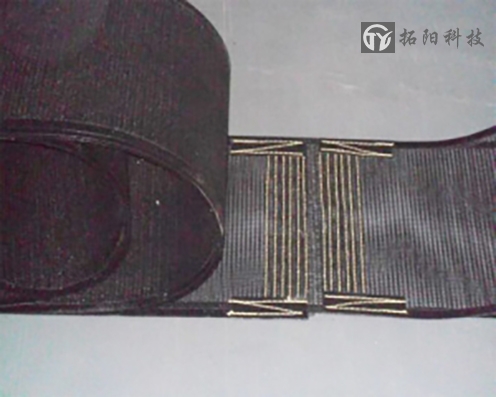Teflon conveyor belt commentary Conveyor belt How to repair after damage
1. Wear forms of conveyor belt in operation
The main reason for the replacement of the conveyor belt is wear, which can be divided into the following three forms: 1) The wear at the vulcanization joint of the conveyor belt is usually due to the high wear resistance of the conveyor belt's own material compared with the rubber layer at the vulcanization joint or the thermal vulcanization quality problem, resulting in local wear of the rubber layer at the vulcanization joint, exposing the steel wire core or nylon core, which poses a serious threat to the strength of the vulcanization joint between the conveyor belts. 2) The conveyor belt is worn at the apron. Due to improper adjustment of the apron of the conveyor belt guide device or poor design of the guide apron, the apron will wear the conveyor belt during operation, causing serious wear of the upper rubber layer on both sides of the conveyor belt. The steel rope core or nylon core is exposed in the longitudinal running direction of the entire belt. Once the steel rope core is warped, it is very easy to wind onto the idler, The steel wire belt is stripped or the tape is torn. 3) The abrasion of the middle part of the conveyor belt is caused by the blanking impact. Since the blanking point of the funnel is relatively fixed, the abrasion of the part of the conveyor belt that bears the impact is intensified, which causes serious local abrasion of the conveyor belt along the running direction, and also causes the exposed steel rope core to spin off or the conveyor belt to tear.
For nylon adhesive tape, the strength of the middle part will be reduced due to the presence of 3 4。 Therefore, under the action of the centripetal force of the carrying idler, the dangerous phenomenon of "belt stacking" will occur during the operation of the belt. 2. Treatment of conveyor belt wear The above wear forms pose a serious threat to the normal operation of the conveyor, but if the conveyor belt is replaced just because of the local strength reduction or local wear, the operating cost will be greatly increased
Therefore, in actual operation, the following measures are adopted for local maintenance. 1) The local thermal vulcanization technology uses a vulcanizer for thermal vulcanization. For the parts where the joints are locally worn, the use of thermal vulcanization technology can restore the performance of the conveyor belt, with good results. The disadvantage is that the manpower and material resources are invested greatly and the time is also long, which is suitable for local treatment of the surface area of vulcanized plate, and it is very difficult to deal with large area wear. 2) The local cold vulcanization technology can basically restore the performance of the conveyor belt by blending the cold vulcanizate in proportion and evenly applying it to the worn surface of the belt after polishing the worn parts. However, the curing time is long, curing at room temperature is about 10~24h, and the surface treatment is not smooth. After the cleaner is put into use, the cleaning effect is not good. 3) The local cold bonding technology generally adopts the repair strip (longitudinal crack) made by Germany Tiptop.

The advantages are less manpower and material input, better wear resistance and reinforcement performance, and shorter recovery time; The disadvantage is that the requirements for the environment are high, the original requirements for the flatness of the conveyor belt surface cannot be restored, and the cleaning effect of the cleaner is not good. But for equipment with high utilization rate, the popularization and application of cold bonding technology effectively alleviates the equipment pressure brought by the limitation of vulcanization technology. 4) The spray repair technology adopts the technology of special equipment spraying polyurea elastomer (PUZPUA), which is a new solvent-free and pollution-free green construction technology. This technology mixes two kinds of liquid materials with special equipment, and sprays them to the worn surface of the conveyor belt under high pressure. The wear-resistant layer is formed according to the required thickness, which is suitable for local wear of continuous pieces and can achieve good results.
The advantages are: ① fast curing, 5s gel, no sagging, and walking strength can be achieved in 1min; ② The construction thickness can range from hundreds of meters to several ems; ③ Excellent physical and chemical properties, such as tensile strength, elongation, flexibility, wear resistance, aging resistance, corrosion resistance, etc. ④ The formula system can be adjusted at will, and the handle ranges from soft rubber (Shao A30) to hard elastomer (Shao D65); ⑤ Convenient construction and high efficiency. The disadvantage is that special equipment is required and external repair is adopted, which makes coordination difficult.
3. Cost and use effect comparison Unit area cost and use effect comparison of various treatment methods. From the cost analysis alone, among the four local wear treatment methods, spraying treatment has a better performance and should be a better choice. Although the initial use effect of the sweeper is not good, as time goes on, the spraying surface will gradually become smooth due to running in, and the cleaning effect will be further improved. Since the conveyor belt is only partially worn longitudinally, and the steel rope or nylon in the core is kept intact, the strength does not decline significantly, and the performance of the conveyor belt can be completely restored by local glue filling. If the spraying width is 0.5m and the thickness is 3mm, the cost of the conveyor belt spraying recovery is only 1/3.3~1/4.4 of the cost of replacing the new belt, which has a great advantage in price. The service life of the replaced belt is statistically compared with that of the sprayed belt. The average service life of the sprayed belt is 1/2 longer than that of the original belt. Combined with the above cost comparison, it is concluded that the spraying technology has a high cost performance ratio
4. It can be seen from the above comparison that the spraying technology for local wear of conveyor belt has high promotion and application value. The conveyor belt is not uniformly damaged as a whole. In many cases, it is the local longitudinal wear of the upper glue layer in the belt section. The structure of the upper glue layer in other parts is normal, and the overall framework of the conveyor belt is good. For such conveyor belts, local spraying recovery has great advantages in reducing costs. Moreover, the higher the investment cost of the new belt (for example, for the belt with large bandwidth, the general spraying cost is only 1/4 of the cost of the new belt, but the service life is 1/2 of that of the new belt), the higher the cost performance ratio. Therefore, spraying can not only reduce the one-time input cost of the conveyor belt, but also save a huge amount of money due to the loss of interest caused by time. In addition, the conveyor belt cannot be sprayed indefinitely. With the extension of service life, there are hidden dangers such as internal steel wire breakage, and the conveyor belt still needs to be replaced according to the specific situation. How to ensure the normal operation of the conveyor belt? The use of the conveyor belt has covered a wide range of areas. As long as there is a conveyor, you can see the conveyor belt. The conveyor belt has many advantages such as safe operation, simple use, saving manpower and material resources, which can reduce the project cost and create greater benefits.
















